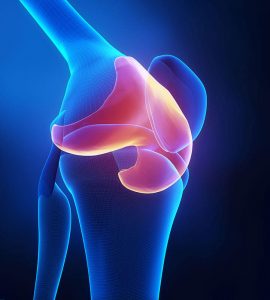The hip is a crucial part of the body responsible for bearing weight and movement. When subjected to intense trauma, the hip joint is susceptible to significant issues, such as fractures, which can cause severe pain and reduced mobility. Timely medical attention helps facilitate recovery and prevents long-term health risks.
What Is a Hip Fracture?
A hip fracture is a break in the upper portion of the thigh (femur) bone near the hip joint. These fractures are common in individuals over 65 with weakened bones due to conditions such as osteoporosis. However, younger individuals may also sustain hip fractures from high-impact collisions or falls or during intense sports or physical activities.
What Are the Types of Hip Fractures?
Hip fractures are classified based on the location and type of bone break. The three common types of hip fractures are:
- Femoral Neck Fractures: Femoral neck fractures occur below the femoral head (ball) of the hip joint. These fractures may disrupt the blood supply to the head of the femur, leading to a severe complication known as avascular necrosis (osteonecrosis).
- Intertrochanteric Fractures: Intertrochanteric fractures typically occur in the area between the neck of the femur and the shaft of the femur. Unlike femoral neck fractures, these fractures maintain blood supply to the bone.
- Subtrochanteric Fractures: Subtrochanteric fractures are found below the lesser trochanter, a small bony prominence on the femur. Although less common than other types, these fractures can be challenging to treat due to the high-stress area of the fracture. They often result from high-energy trauma or weakened bones due to osteoporosis.
What Are the Symptoms of a Hip Fracture?
The symptoms of a hip fracture can vary depending on the severity and location of the break, but some common signs include:
- Difficulty bearing weight on the affected limb
- Inability to stand or walk following a fall
- Severe pain in the hip, groin, and lower back
- Bruising, swelling, and stiffness in and around the hip region
- Shortening of the injured leg
- An outward turning of the leg at the injured hip
What Causes a Hip Fracture?
Hip fractures are primarily caused by the following:
- Falls: This is the most common cause of hip fractures, particularly among older individuals with weakened bones or osteoporosis, balance issues, or impaired vision.
- Direct Impact: Even younger individuals may experience hip fractures resulting from high-energy impacts, such as vehicle accidents or falls from a great height.
- Repetitive Stress: Repeated high-impact activities significantly increase the risk of hip fractures. This is particularly common among athletes, especially those who participate in long-distance running or strenuous physical activity without proper preparation and conditioning.
What Are the Risk Factors for Hip Fractures?
Other factors that can put an individual at risk of hip fractures include:
- Older Age: The risk significantly increases with advancing age.
- Female Sex: Women are more prone due to hormonal changes after menopause, which can lead to bone loss.
- Family History of Osteoporosis: Genetic predisposition plays a role.
- Vitamin D and Calcium Deficiency: Inadequate intake weakens bones.
- Physical Inactivity: Lack of exercise contributes to decreased bone density and muscle strength.
- Excessive Alcohol and Smoking: These habits negatively impact bone health.
- Chronic Medical Conditions: Conditions like arthritis and balance disorders increase fall risk.
- Certain Medications: Long-term use of corticosteroids (like prednisone) and other drugs can weaken bones.
How Are Hip Fractures Diagnosed?
Doctors begin diagnosing hip fractures by gathering the patient’s medical history and conducting thorough physical examinations to check for any signs of swelling, tenderness, or deformity.
Should these physical signs suggest a potential fractured hip, doctors will then recommend imaging tests, such as:
- X-ray: This is typically the primary diagnostic tool used to determine the site and severity of the hip fracture.
- MRI: An MRI scan employs radio waves and a strong magnetic field to generate detailed images of the hip area and soft tissues and detect minor fractures that are not visible through X-rays.
- CT Scan: This test uses a combination of X-rays and a computer to provide cross-sectional images of the hip joint and surrounding tissues, allowing doctors to identify muscle damage and bone abnormalities.
What Are the Hip Fracture Treatments Available?
Surgery is the mainstay of treatment for most hip fractures. A surgery for a fractured hip is typically done within 24-48 hours after diagnosis to improve outcomes and reduce complications.
In Singapore, hip fracture treatment often involves one of two surgical approaches, tailored to the fracture’s location and the degree of bone displacement. These are:
- Hip Replacement (Hip Arthroplasty): Hip replacement surgery involves replacing damaged portions of the hip joint with artificial implants (prostheses). It can be a partial hip replacement, where the surgeon replaces only the femoral head, or a total hip replacement, where both the femoral head and the pelvis socket are replaced.
- Open Reduction and Internal Fixation (ORIF): ORIF is a surgical procedure used to stabilise and repair complex or severe hip fractures. It involves repositioning the bone fragments (open reduction) and securing them with surgical hardware like pins, screws, or rods (internal fixation) for proper alignment while they heal.
What Are the Complications of a Hip Fracture?
Hip fractures can lead to several complications, particularly if not addressed promptly and effectively. These include:
- Worsening pain and discomfort at the injury site
- Wasting or thinning of muscle tissue (muscle atrophy)
- Prolonged mobility issues
- Blood clots in the veins of the legs (deep vein thrombosis)
- Pneumonia or bed sores from prolonged immobility
How Can You Prevent Hip Fractures?
Hip fractures may not always be avoidable, especially in the case of sudden falls or other trauma. However, implementing the following strategies can contribute significantly to bone health:
- Ensure adequate calcium and vitamin D intake
- Engage in regular weight-bearing exercises like walking
- Avoid excessive alcohol consumption and smoking
- Take prescribed medications to manage osteoporosis or bone loss
- Assess the home environment for trip hazards
- Get routine bone density screenings, especially for older individuals
FAQs About Hip Fractures
Can you still walk with a broken hip?
Walking with a fractured hip is often extremely painful and can worsen the injury. If you experience unusual symptoms, immediate medical attention is necessary to assess and treat the injury appropriately.
Can you move a person with a broken hip?
Moving someone with a suspected hip fracture should be avoided to prevent further injury. It is crucial to seek emergency medical assistance and allow healthcare professionals to manage the situation safely.
Do all hip fractures require surgery?
There are some cases where conservative approaches may be considered for fractured hips, especially if surgery is not feasible due to advanced age or other existing conditions that could pose significant risks.
To relieve pain and prevent further injury, doctors may recommend non-surgical hip fracture treatments, such as:
- Pain medications such as NSAIDs, acetaminophen, opioids, or nerve-block injections
- Assistive devices, such as crutches and walkers, to relieve weight on the affected hip
- Physiotherapy to help maintain mobility, strengthen muscles, and improve balance and coordination
In Summary
Hip fractures are a debilitating medical condition that significantly impairs mobility and joint function. With appropriate and timely medical intervention, however, patients can greatly improve their prognosis and regain independence.Our orthopaedic clinic specialises in managing various types of hip fractures. We will conduct a comprehensive assessment of your condition and offer effective treatment and support. Give us a call at 8028 4572 to schedule a consultation.

MMed (Orth), FRCS Orth & Tr (Edin)
Dr James Tan is a trusted orthopaedic surgeon in Singapore with over 10 years of experience in sports surgery and exercise medicine. He has treated athletes from Singapore’s national teams and professional football leagues. A specialist in knee, shoulder, and elbow injuries, Dr Tan is also skilled in minimally invasive tendon and ligament repair, cartilage and meniscus surgery, and joint replacement. He is a founding member of the Singapore Shoulder and Elbow Surgery Society and a fellow of the Royal College of Surgeons (Edinburgh). Committed to research and education, Dr Tan leads various research projects and serves as Adjunct Assistant Professor at both NUS and NTU medical schools.




